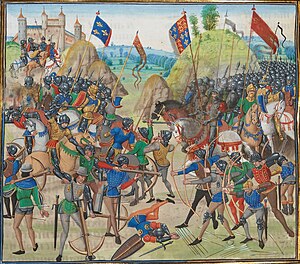Our website is made possible by displaying online advertisements to our visitors.
Please consider supporting us by disabling your ad blocker.
English longbow


The English longbow was a powerful medieval type of bow, about 6 ft (1.8 m) long. While it is debated whether it originated in England or in Wales from the Welsh bow, by the 14th century the longbow was being used by both the English and the Welsh as a weapon of war and for hunting. English longbows were effective against the French during the Hundred Years' War, particularly in the battles of Sluys (1340), Crécy (1346), Poitiers (1356), and Agincourt (1415). They were less successful later on, as longbowmen had their lines broken at the Battle of Verneuil (1424), although the English won a decisive victory there; they were completely routed at the Battle of Patay (1429) when they were charged by the French mounted men-at-arms before they had prepared the terrain and finished defensive arrangements. The Battle of Pontvallain (1370) had also previously shown longbowmen were not particularly effective when not given the time to set up defensive positions.
No English longbows survive from the period when the longbow was dominant (c. 1250–1450),[1] probably because bows became weaker, broke, and were replaced rather than being handed down through generations.[2] More than 130 bows survive from the Renaissance period, however. More than 3,500 arrows and 137 whole longbows were recovered from the Mary Rose, a ship of Henry VIII's navy that sank at Portsmouth in 1545.
Previous Page Next Page


